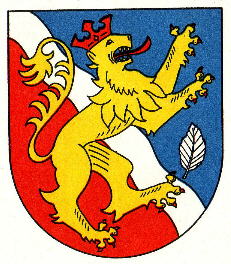Georgweierbach: Difference between revisions
Knorrepoes (talk | contribs) m (Text replacement - " / Arms" to "/Arms") |
Knorrepoes (talk | contribs) m (Text replacement - "Literature :" to "'''Literature''':") |
||
| Line 28: | Line 28: | ||
{{media}} | {{media}} | ||
[[Civic Heraldry Literature - Germany|Literature]] : Heyen und Zimmer, 1966 | [[Civic Heraldry Literature - Germany|'''Literature''']]: Heyen und Zimmer, 1966 | ||
[[Category:German Municipalities G]] | [[Category:German Municipalities G]] | ||
Revision as of 09:00, 9 September 2022
This page is part of the German heraldry portal Deutsche Wappensammlung |
Heraldry of the World |
|
German heraldry:
|
Selected collector's items from Germany:
|
GEORGWEIERBACH
State : Rheinland-Pfalz
District (Kreis) : Birkenfeld
Incorporated into: 1970 Idar-Oberstein
| German | Schild von Rot und Blau durch silbernen Wellenschrägbalken geteilt, belegt mit rotbewehrtem, -gezungten und -gekrönten goldenen Löwen nach links, hinten ein silbernes Hainbuchenblatt. |
| English | No blazon/translation known. Please click here to send your (heraldic !) blazon or translation |
Origin/meaning
The arms were officially granted on October 15, 1965.
The lion is taken from the arms of the medieval Lords of Wierbach, who had their castle in the village. The blue and red colours are derived from the arms of Oldenburg, as the area belonged to Oldenburg for a long period of time.
The wavy silver bend is a canting symbol for the -bach part of the name (Bach means river). The leaf is a leaf of he Common hornbeam (Carpinus betulus), Hainbuche in German, as the village is known in the area as Hambiiche.
Contact and Support
Partners:
Your logo here ?
Contact us
© since 1995, Heraldry of the World, Ralf Hartemink 
Index of the site
Literature: Heyen und Zimmer, 1966












